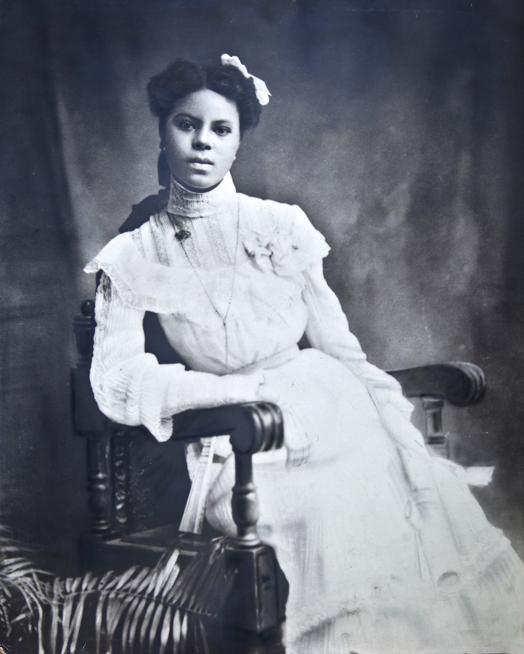Lucile Berkeley Buchanan
Full Article
Lucile Berkeley Buchanan (1884–1989) was a gifted teacher and the first African American to graduate from the State Normal School of Colorado (today, the University of Northern Colorado in Greeley) in 1905. Following graduation, she occasionally worked as a substitute teacher; race-based discrimination prevented her from getting a permanent teaching job. In 1916 she enrolled at the University of Colorado in Boulder, and two years later, she became the first Black woman known to have earned a bachelor’s degree there. Determined to become an educator, she took her Colorado teacher training to Arkansas, where she was able to teach in Black schools. She fulfilled her dream of becoming a classroom teacher in Kansas City and Chicago, where she taught in segregated schools.
Early Life
Lucile Berkeley Buchanan was born in a shed on June 13, 1884, at 120 Platte Street in Denver, an area locally known as the South Platte River bottoms. Her parents, James and Sarah Buchanan, were formerly enslaved people from Loudoun County, Virginia, who had arrived with their four children in 1882. Lucile was their first Colorado-born child. Life along the bottoms was rough. The river often flooded, filthy alleys, extreme noise, and dirt from the railroad tracks, and typhoid fever outbreaks were common. Reaching their limits, in 1886, the Buchanans moved to an unfinished property southwest of Denver that Sarah bought for $100 from the circus showman P. T. Barnum.
After graduating in June 1901 from Villa Park High School, Lucile enrolled two years later in a teacher-training program at the State Normal School in Greeley. Students there received free tuition if they agreed to teach in public schools after graduation. Lucile had a largely positive experience in Greeley, where she lived with an abolitionist family and was able to participate in the school’s graduation ceremony.
When she returned home from Greeley with an associate degree in 1905, Lucile began applying for permanent teaching positions. At every step, her applications were denied. She even applied for a position in Maitland, a coal-mining town in southern Colorado. Her application drew such attention that on July 25, 1905, the Walsenburg World ran an article titled “Colored Teaching Applicant.” Buchanan was rejected. The only positions she could secure were substitute teaching jobs in the few predominantly white schools with Black students.
Over the years, Buchanan’s struggle to find a job did not go unnoticed. On June 13, 1908, Joseph D. D. Rivers, editor of the Statesman, Denver’s Black newspaper, penned a riveting editorial titled “We Shall Try Again.” It quoted a school board member who had “no objections of Colored teachers in mixed schools but feared the objections of white parents.” The Rocky Mountain News also ran an article about Buchanan’s dilemma, “One of the Best Colored Girls of the West failed to make a difference.”
Work Outside Colorado
For her part, Buchanan did not dwell on her disappointment. In 1907 she contacted her pastor at Zion Baptist Church, the Reverend John E. Ford, and within days she was offered a full-time teaching position at Arkansas Baptist College in Little Rock. When her contract expired in 1912, she landed a job at Langston High School in Hot Springs, Arkansas, where she remained until her return to Colorado in 1915 to attend the University of Colorado in Boulder, where she started the following year. In 1918 Buchanan earned a degree in German, although she was not allowed to walk on stage to accept it.
After completing her bachelor’s degree, Buchanan was hired to teach English at Lincoln High School in Kansas City in 1919. Her last teaching job, where she taught from 1925 to her retirement in 1940, was at the Douglas School in Chicago’s Black Belt, a community that bore some similarities to Denver’s Five Points.
Buchanan focused on teaching her students decision-making and critical thinking skills, which she believed would help them navigate life in a segregated society. When the administration at Lincoln High School rejected her idea to introduce a global studies course, she created an after-school World News Club. In 1925, before she left for Chicago, she also started the first school newspaper at Lincoln High. Inspired by Black newspapers in Denver and Kansas City, The Observer was a four-page publication that sold for five cents a copy. By teaching about the world beyond the United States and empowering them to write about their communities from their own perspectives, Buchanan helped her Black students counteract the idea that they were inferior.
Later Life and Legacy
Lucile Buchanan regularly returned to Colorado, taking summer classes at the University of Denver to upgrade her salary. In 1949 she retired to the home her father built in the Barnum neighborhood in the 1890s, which still stands today. She eventually hired a German man named Herman Dick to care for her daily affairs as she aged. Lucile Buchanan died in 1989 at the age of 105. She is buried at Denver’s Fairmount Cemetery.
Buchanan’s lifetime of struggle, achievement, and teaching inspired generations beyond her living years. In Buchanan’s time, it was nearly miraculous for a woman of color to pursue and obtain a college degree, and neither was it easy to instill that same kind of hope and self-worth in a generation of Black students who lived amid daily reminders that they were not considered full or equal citizens.
Wherever she taught, Buchanan’s contributions have been lauded. Students at Lincoln High School in Kansas City lamented her departure in 1925, with one even predicting she would soon teach at Harvard. In 1970, in a story covering the 114th anniversary of Langston High School in Hot Springs, Arkansas, the local newspaper listed Buchanan among six teachers who “left a lasting impression on the community.” In April 2010, CU-Boulder established a scholarship in her name. In 2018 she was honored at the State Capitol by State Senator Rhonda Fields.


